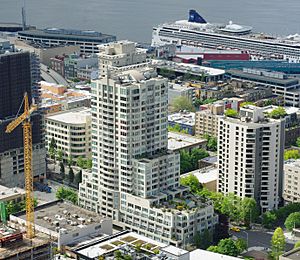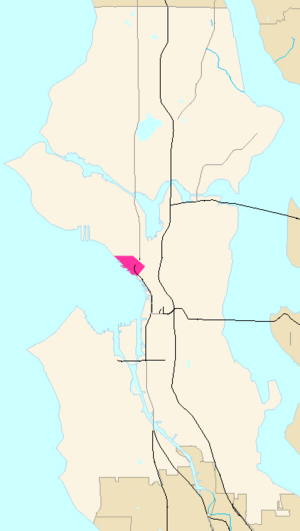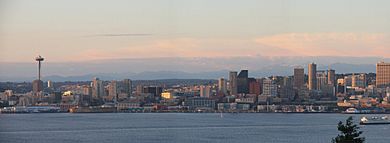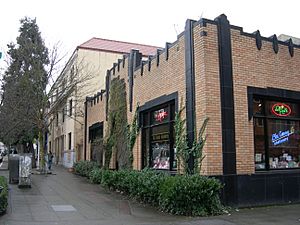Belltown, Seattle facts for kids
Quick facts for kids
Belltown, Seattle
|
|
|---|---|
|
Seattle Neighborhood
|
|

Aerial view of Belltown looking at 2600 Second Avenue (presently Seattle Heights Condos)
|
|

Belltown Highlighted in Pink
|
|
| Country | United States |
| State | Washington |
| County | King |
| City | Seattle |
| Named for | William Nathaniel Bell |
| Zip Code |
98121
|
| Area Code | 206 |
Belltown is a lively neighborhood in Seattle, Washington, United States. It's known for being the most crowded neighborhood in Seattle. It sits right on the city's waterfront.
Long ago, this area was a place with lower rents and many artists. It also had some factories. But over the years, Belltown has changed a lot. Now, it's full of cool restaurants, unique shops, fun nightclubs, and tall apartment buildings. You can still find some warehouses and art galleries too.
The neighborhood got its name from William Nathaniel Bell. He owned the land where Belltown was built. In 2007, a group called CNNMoney said Belltown was the best place to retire in the Seattle area. They liked that you could walk everywhere and find everything you needed.
Belltown is also home to a few universities, like Antioch University and City University of Seattle. It's very close to the Denny Triangle neighborhood. That's where Amazon has its big offices downtown.
Contents
Exploring Belltown
Belltown is a great place to explore. It has a mix of old and new businesses. Many new shops and restaurants have opened. But some classic spots are still very popular.
Fun Places to Visit
If you're looking for classic Seattle nightspots in Belltown, check out places like The Rendezvous, The Lava Lounge, and The Crocodile Cafe. The very first Ace Hotel was started in Belltown, and it's still there today.
Where is Belltown?
Belltown is located right next to Elliott Bay on the water. To the north, you'll find Seattle Center, which is home to the Space Needle. To the southeast, it's close to the famous Pike Place Market and the rest of Downtown Seattle.

Major streets like Alaskan Way, Elliott Avenue, and 1st, 2nd, 3rd, and 4th Avenues run through Belltown. There's also a big tunnel, the State Route 99 tunnel, that goes underneath Belltown. It helps connect different parts of the city.
Unique Spots in Belltown
On Western Avenue, you can find the Belltown P-Patch and Cottage Park. A P-Patch is a community garden where people can grow their own plants. The cottages there are very old, built in 1916. They are the last wooden homes left in downtown Seattle. They also show where the shoreline used to be back in the 1850s!
Olympic Sculpture Park
On the northern edge of Belltown, right by the water, is the Olympic Sculpture Park. This is a large outdoor garden filled with amazing sculptures. It's about 9 acres big. The park also has different plant areas that are native to the Pacific Northwest. There's even a restored beach and seawall.
The Seattle Art Museum runs this park. What's really cool is that it's completely open to the public. You don't need a ticket, and there are no walls around it. It's a great place to see art and enjoy nature.
Getting Around Belltown
Belltown has many ways to get around using public transportation. King County Metro operates many bus routes here. This includes fast bus services called RapidRide. The RapidRide E line is very popular. It connects North Seattle to Downtown Seattle, passing right through Belltown.
You can also use the light rail system. Westlake Station is just south of Belltown. From there, you can take Sound Transit's 1 Line to travel across the Seattle area.
Belltown's "Film Row" History
Did you know Belltown used to be a big center for the movie industry? It was once known as "Film Row." This was a special area where movie companies had their offices and stored their films.
Why "Film Row"?
Back in the early 1900s, movies were made on a material called nitrocellulose film. This type of film was very flammable, meaning it could easily catch fire. Because of this danger, cities often made rules about where film companies could store their movies. In Seattle, many film companies gathered in Belltown. This made it easier to manage the safety risks.
By the 1920s, Seattle's "Film Row" was a busy place. Film companies here would send movies to about 470 movie theaters across Washington, Idaho, Montana, and Oregon.
What Remains Today?
Most of the original "Film Row" buildings are gone now. However, you can still see some hints of this history. The Jewel Box theater inside The Rendezvous bar is one of the last old screening rooms in the neighborhood.
Other buildings that were once part of "Film Row" still stand. The McGraw-Kittenger-Case building, for example, used to be the MGM building. Now, it's a bar and restaurant. The former William Tell Hotel, which was popular with film industry workers, is now a traveler's hostel. The old National Theater Building also houses several small businesses.
At 2332 First Avenue, the building that once housed Paramount Pictures' film exchange is now home to the Catholic Seaman's Club and a restaurant called Sarajevo. These buildings are a reminder of Belltown's exciting past in the movie business.


